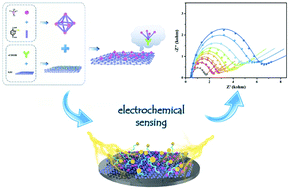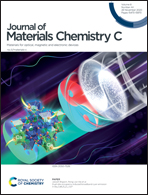Ingenious fabrication of metal–organic framework/graphene oxide composites as aptasensors with superior electrochemical recognition capability†
Abstract
The expansion and fabrication of available metal–organic framework (MOF)/graphene oxide (GO) composites is of great importance because of their expectedly splendid properties and extensive applications. In this work, MOF/GO composites are ingeniously fabricated via monolayer dispersed UiO-66-NH2 on the surface of GO. The obtained composites possess various merits from UiO-66-NH2 and GO to immensely enhance the electrochemical recognition capability, which is mainly ascribed to the strong affinity between the phosphate terminal of the aptamer and the Zr6 cluster of UiO-66-NH2, and to the presence of π–π stacking force between the heterocyclic ring of the aptamer and GO. With adenosine triphosphate (ATP) as analyte, the fabricated UiO-66-NH2/GO-based aptasensor has the limit of detection (LOD) of 1.69 fg mL−1 (3.33 fM) in a wide concentration range of 1.0 × 10−5–5.0 ng mL−1, via electrochemical impedance spectroscopy. In terms of preferable stability, operability and repeatability, this biosensor reveals a potentially practical use value for monitoring ATP in real samples. Thus, this work exhibits an effective synthetic strategy to fabricate MOF/GO hybrid composites and further expands their electrochemical sensing applications.



 Please wait while we load your content...
Please wait while we load your content...